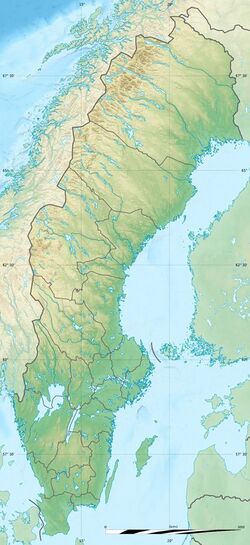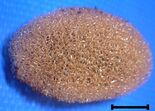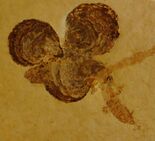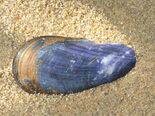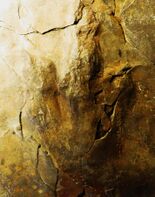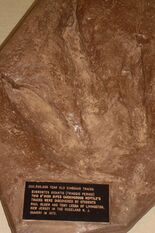Höganäs Formation
Topic: Earth
 From HandWiki - Reading time: 11 min
From HandWiki - Reading time: 11 min
| Höganäs Formation Stratigraphic range: Rhaetian-Hettangian ~202–199 Ma | |
|---|---|
| Type | Geological formation |
| Unit of | Ängelholm Trought |
| Sub-units | Bjuv, Helsingborg & Vallåkra members |
| Underlies | Rya Formation |
| Overlies | Kågeröd Formation |
| Thickness | 200 m |
| Lithology | |
| Primary | Sandstone |
| Other | Shale, coal |
| Location | |
| Coordinates | [ ⚑ ] : 56°06′N 12°42′E / 56.1°N 12.7°E |
| Paleocoordinates | [ ⚑ ] 44°36′N 8°30′E / 44.6°N 8.5°E |
| Region | Skåne |
| Country | |
| Type section | |
| Named by | Troedsson[1] |
The Höganäs Formation is a Late Triassic to Early Jurassic geologic formation in Skåne, Sweden. The formation is mostly known for its incredible flora collection from the Bjuv member, composed of over 110 species, and also includes several vertebrate remains, such as fishes, amphibians and dinosaur tracks & remains, although none have yet been referred to a specific genus.[2]
Description
The Höganas Formation was deposited in what is now the southern part of Sweden Skåne. The formation straddles the Triassic-Jurassic boundary and has provided evidence of widespread mire-forest deterioration that began in the latest Rhaetian.[3] The upper part of the Höganas Formation is correlated with the Rønne Formation of Bornholm, which is administered by Denmark. The Hóganas Formation is rich in coal and has provided many fossil flora.[4]
Vallåkra Member
This member represent the basal part of the Formation, that represents a transition between the terrestrial Kågeröd Formation and the delta dominated coal layers of the Bjuv Member, being made by poorly stratified clay & claystone, mostly green in coloration.[5] The sediments of this member are exposed mostly in the quarry of the town of the same name, where is subdivided on the next levels: 6 m of mixed layers, whose composition includes material seen both on the Kågeröd Formation and this member (red clay and 5 m light clay, 3 m argillaceous sandstone and l m dark clay and several layers composed by Spherosiderite).[5] The uppermost levels are covered by the coal seams of the Bjuv Member. This member has been considered as of Middle and Upper Rhaetian in age.[5][6]
Bjuv Member
The second member is the Bjuv Member, known as the most fossiliferous one, that was known originally as the Gruv Member (gruva= mine).[6][7] Coal and clay have been mined in this area since the fifteenth century, being this intensive mining one of the main reasons the fossiliferous layers have provided such a diverse flora. The Bjuv member is divided on two different seams, the B seam, that overlies the older member and the A seam, that marks the limit with the Helsingborg Member.[6] This layer has a thickness of around 37.22 and 45.72 m in bore No. 256 (stored at the Höganäs Company in Bjuv) from the Bjuv area.[5] The layer is dominated by coarse arenaceous sediments, specially between Billesholm and Höganäs, parallel to the Söderåsen and Kullaberg horsts.[7] Towards the southern part of this area the deposition changes, with an increased abundance of argillaceous contents, specially at places like Skromberga.[7] The age of this member is considered to be Late Rhaetian-Lower Hettangian. The Plant fossils found at this layer are one of the main fossil material of the whole Mesozoic in Sweden, composed by more than 110 species, one of the most complete floras of the same age from any location.[6][8] The main reason for this datation where suggested due to the presence of the plants Lepidopteris ottonis and Thaumatopteris shenki, as well palynological samples that suggested a Middle Rhaetian age (the Rhaetipollis-Limbosporites Miospore Zone).[9] Latter works have fount that the Dinosaur Footprint layers spam between the Rhaetian-Hettangian boundary.[10] Beyond the exceptional flora, the member is also known for fossils of Molluscs, arthropods and fish remains.[6]
Helsingborg Member
The Uppermost member of the formation is entirely of Hettangian age, and is the last layer before the start of the deposition of the younger dominant marine Rya Formation.[5] This member is dominated by Deltaic sediments, along several marine interealatians are frequent, with deposition of coarse, in some cases arkosic sandstones in between more fine-grained deposits may indicate Early Kimmerian tectonic movements.[11] The member has a maximunn thickness of 215 m and is divided in 2 parts: Höllviken No. 2 indicated that the lower part starts with up to 12 m of kaolinitic clay succeeded by a 15–20 m thick sequence of cross-bedded arkoses and light-coloured clays, being called Boserup beds or Thaumatopteris schenki zone (Pinuspollenites-Trachysporites Miospore Zone).[12][13] by Lund ( 1977) This beds are known from Boserup, but also from the central part of Helsingborg, the Köpinge No. 3 bore and even extent to the Höganäs region (northwest to Eslöv in the south).[6] This beds are overlain by some metres of arenaceous clays, iron claystone and calcareous sandstone with few intercalation of a coal seam (known as Tågaborg coal seam), where floral remains are also recovered such as Dictyophyllum nilssoni and Equisetites spp..[6] Then the layers turn into 5 m of argillaceous sandstone and 5 m slightly arenaceous clays, with a last 1 m of calcareous sandstone, on a sequence known from cliff series at Laröd-Sofiero at the north of Helsingborg, with plant remains such as Nilssonia polymorpha and Dictyophyllum nilssoni, referred to the Pinuspallenites-Trachysporites zone.[5] It also appears on Rosendal, Fleninge, Farhult and Klappe.[5] Helsingborg (Vossbäumer I 969). There is a coal seam, Tinkarpsflötsen, in the middle part of the sequence. The upper part of the Helsingborg Member starts with a 28 m thick sandstone, with a section known as Fleninge beds, that represent layers where marine ingressions were more common, with the last layers of the formation made up of sandstone, claystone and several minor coal seams.[5]
Fossil content
Ichnofossils
- Lockeia siliquaria (Bivalves)[14]
- Planolites annularis (Polychaetes)[14]
- Planolites montanus (Polychaetes)[14]
- Diplichnites isp. (Xiphosurans, Insects, Arachnids)[14]
- Teichichnus isp. (Polychaetes, Echiurans, Holothurians.)[14]
- Skolithos isp. (Polychaetes, Phoronidans)[14]
- Monocraterion tentaculatum (Polychaeta, Sipuncula, Enteropneustans & Echiurans)[14]
- Rhizocorallium isp. (Polychaeta, Sipuncula, Enteropneustans & Echiurans)[14]
- Aulichnites isp. (Gastropods)[14]
- Diplocraterion parallelum (Polychaeta, Sipuncula, Enteropneustans & Echiurans)[14]
Annelida
| Genus | Species | Stratigraphic position | Member | Material | Notes | Images |
|---|---|---|---|---|---|---|
|
"Cycadeospermum"[15] |
|
|
|
Cocoons |
Freshwater Clitellata Cocoons (Oligochaeta and Hirudinea), identified with palynological residues. Also called "red eggs" and present on the estuarine series of Yorkshire |
 Placobdella, example of leech |
|
Burejospermum[15] |
|
|
|
Cocoons |
Freshwater Clitellata Cocoons (Oligochaeta and Hirudinea), identified with palynological residues, and through to be tridimensional nets of probable algal origin. Fragmentary mesh-like networks of happiness threads composed of homogenous translucent material. They show the outer wall (hapsine) construction specific to clitellate annelids and lack an alytine (inner) layer. A disorderly meshwork of the hapsine layer and hapsine fibers of unequal thickness, are diagnostic of the type species Dictyothylakos pesslerae. The cocoons Dictyothylakos pesslerae resemble specially those of modern Leechs, and are common on flooded basin sediments, which implies not only the presence of parasitic leeches, but also the presence of large hosts nearby, as has been confirmed by Dinosaur Footprints | |
|
Dictyothylakos[15] |
|
|
|
Cocoons |
Freshwater Clitellata Cocoons (Oligochaeta and Hirudinea), identified with palynological residues, and through to be tridimensional nets of probable algal origin. Fragmentary mesh-like networks of happiness threads composed of homogenous translucent material. |
Bivalves
| Genus | Species | Location | Stratigraphic position | Material | Notes | Images |
|---|---|---|---|---|---|---|
|
Eutrapetzium[5] |
Eutrapetzium pullastra |
|
|
Isolated Shells |
An Oyster, member of Ostreidae inside Ostreida. The local material assigned to this genus is now lost |
|
|
Liostrea hisingeri |
|
|
Isolated Shells |
An Oyster, member of Ostreidae inside Ostreida. The most common Bivalve found locally, indicator of increased salinity levels on the Hettangian layers. |
||
|
Cardinia[5] |
Cardinia ingelensis |
|
|
Isolated Shells |
A Clam, member of Cardiniidae inside Carditida. |
|
|
Modiolus hoffinanni |
|
|
Isolated Shells |
Insecta
| Genus | Species | Location | Stratigraphic position | Material | Notes | Images |
|---|---|---|---|---|---|---|
|
Nannocurculionites[16] |
Nannocurculionites carlsoni |
|
Bjuv member |
Elytrons |
A beetle, incertae sedis Archostemata inside Coleoptera. Originally identified as Curculionites carlsoni |
|
|
Heeriaopsis[16] |
Heeriaopsis laevigatum |
|
Bjuv member |
Elytrons |
A beetle, incertae sedis Archostemata inside Coleoptera. |
|
|
Angelinella[16] |
Angelinella angelini |
|
Bjuv member |
Elytrons |
A beetle, incertae sedis Archostemata inside Coleoptera. |
|
|
Parabuprestites[16] |
Parabuprestites rugulosus |
|
Bjuv member |
Elytrons |
A Beetle, member of the family Cupedidae inside Coleoptera. Originally identified as Buprestites rugulosus |
|
|
Pseudohydrophilites[16] |
Pseudohydrophilites nathorsti |
|
Bjuv member |
Elytrons |
A Beetle, member of the family Schizocoleidae inside Coleoptera. Originally identified as Hydrophilites nathorsti. This genus is widely distributed in the latest triassic beds, being found also in places such as Franconia. |
|
|
Pseudocarabites[16] |
Pseudocarabites deplanatus |
|
Bjuv member |
Elytrons |
A Beetle, member of the family Carabidae inside Coleoptera. Originally identified as Carabites deplanatus. |
Sharks
| Genus | Species | Location | Stratigraphic position | Material | Notes | Images |
|---|---|---|---|---|---|---|
|
Palaeoxyris muensteri |
|
|
|
A freshwater shark, likely produced by members of Hybodontidae. Originally identified as Spirangium, considered gigantic Chara, fresh-water green algae (stone-worths). The palynological and palynofacies data points to a predominantly freshwater depositional environment, with the eggs are found in close association with Neocalamites hoerensis stems (An ideal substrate for hybodont sharks to attach their eggs to).[17] |
||
| Hybodus[18] | Hybodus sp. |
|
|
|
A freshwater/marine shark, member of Hybodontidae inside Hybodontiformes | |
|
Lissodus sp. |
|
|
|
A freshwater/marine shark, member of Lonchidiidae inside Hybodontiformes. |
||
| Parvodus[18] | Parvodus |
|
|
|
A freshwater/marine shark, member of Lonchidiidae inside Hybodontiformes |
Bony Fish
| Genus | Species | Location | Stratigraphic position | Material | Notes | Images |
|---|---|---|---|---|---|---|
| Hyllingea[19] | Hyllingea swanbergi |
|
Bjuv member (Rhaetian) |
|
A freshwater bony fish, member of the family Acrolepidae inside Paleonisciformes. |  Acrolepis, a relative of Hyllingea |
| Saurichthys[20] | Saurichthys acuminatus | (Rhaetian) | A freshwater bony fish, member of the family Saurichthyidae inside Saurichthyiformes. | |||
|
Scanilepis dubia |
|
Bjuv member (Rhaetian) |
|
A freshwater bony fish, member of the family Scanilepididae inside Paleonisciformes. Originally identified as Gyrolepis dubia, with a planned redescription that was impossible due to the Second World War and never materialized |
||
| Semionotus[20] | Semionotus nilssoni | (Rhaetian) | A freshwater bony fish, member of the family Semionotidae inside Semionotiformes. |
Amphibia
| Genus | Species | Location | Stratigraphic position | Material | Notes | Images |
|---|---|---|---|---|---|---|
|
Gerrothorax pulcherrimus |
|
Bjuv member (Rhaetian) |
|
An amphibian, member of the family Plagiosauridae. Represents the only major tetrapod macrofossil from this layers. |
Dinosauria
Tracks discovered in the Höganäs Formation have been assigned to the ichnogenus Grallator (Eubrontes) cf. giganteus, which were discovered in Rhaetian strata, and Grallator (Eubrontes) soltykovensis, which were discovered in Hettangian strata.[24] A few of the tracks were taken to museums, but most of them disappeared in natural floodings.[24]
After the end of a seven-year excavation project at Billesholm, researchers announced on 13 October 2022 the identification of seven dinosaur species based on fossil remains, out of which three species were new to science.[25] The fossils are yet to be analyzed and scientifically published.[26]
| Genus | Species | Location | Stratigraphic position | Material | Notes | Images |
|---|---|---|---|---|---|---|
|
|
|
Footprints |
Theropod tracks, member of the ichnofamily Eubrontidae, incertae sedis inside Neotheropoda. The footprints are small-sized, tridactyl and relatively narrow. Likely made by Coelophysidae-like dinosaurs. |
||
|
|
|
Footprints |
Theropod tracks, type member of the ichnofamily Eubrontidae, incertae sedis inside Theropoda. Eubrontes tracks were likely made by Dilophosaurus-like theropods. |
||
|
Theropoda? Indeterminate[2] |
|
Helsingborg member |
|
Incertae sedis Dinosaurian remains, suggested to be from an indeterminate Theropod |
||
|
Moyenisauropus[30] |
|
|
|
Footprints |
Thyreophoran tracks, type member of the ichnofamily Moyenisauropodidae, incertae sedis inside Neornithischia. Is considered synonymous with the ichnogenus Anomoepus. The tracks described resemble basal Thyreorphora feet. |
 Scelidosaurus matches with the bodyplan assigned to the Moyenisauropus trackmaker |
See also
- List of fossiliferous stratigraphic units in Sweden
- List of dinosaur-bearing rock formations
- List of stratigraphic units with indeterminate dinosaur fossils
References
- ↑ Troedsson, G. T. (1934). "Undersökning av möjligheten att erhålla grundvatten från Hälsingborgstraktens berggrund.". Hälsingborgs S tadsfullm 1 (1): 25–30.
- ↑ 2.0 2.1 Weishampel, et al. (2004). "Dinosaur distribution." Pp. 517-607.
- ↑ Petersen & Lindström, 2012, p.8
- ↑ Petersen & Lindström, 2012, p.9
- ↑ 5.00 5.01 5.02 5.03 5.04 5.05 5.06 5.07 5.08 5.09 5.10 5.11 Sivhed, Ulf (1984). "Litho-and biostratigraphy of the Upper Triassic-Middle Jurassic in Scania, southern Sweden". Sveriges geologiska undersökning 31 (12): 31–50. http://resource.sgu.se/produkter/c/c806-rapport.pdf. Retrieved 11 February 2021.
- ↑ 6.0 6.1 6.2 6.3 6.4 6.5 6.6 Troedsson, G.T. (1950). On rhythmic sedimentation in the Rhaetic-Liassic beds of Sweden (1 ed.). London: lnt. Geol. Congr. Rep. XVIII S ession. pp. 64–72. https://paleoarchive.com/literature/Troedsson1950-RhythmicSedimentationRhaeticLiassicSweden.pdf. Retrieved 12 December 2021.
- ↑ 7.0 7.1 7.2 Bölau, E. (1959). "Der Sudwest- und Slidostrand des Ballisehen Schildes (Schonen und Ostbaltikum)". Geologiska Föreningen i Stockholm Förhandlingar 7 (1–2): 167–230. doi:10.1080/11035895909449146.
- ↑ Lundblad, Britta (1959). "Rhaeto-Liassic floras and their bearing on the stratigraphy of Triassic-Jurassic rocks". STHLM. Contrib. Geol. 16 (1): 83–102.
- ↑ Nathorst, A.G. (1878–1886). "Om floran i Skånes kolförande bildningar. l. Floran vid Bjuf". Sver. Geol. Unders 27 (33): 0–131. https://resource.sgu.se/dokument/publikation/c/c29rapport/c29-rapport.pdf. Retrieved 12 December 2021.
- ↑ 10.0 10.1 Vajda, V.; Calner, M.; Ahlberg, A. (2013). "Palynostratigraphy of dinosaur footprint-bearing deposits from the Triassic–Jurassic boundary interval of Sweden". GFF 135 (1): 120–130. doi:10.1080/11035897.2013.799223. https://www.diva-portal.org/smash/get/diva2:873005/FULLTEXT01.pdf. Retrieved 12 December 2021.
- ↑ Norling (1982). "Post-Palaeozoic Tectonics of Scania. In Bergström el al.: Guide to excursions in Scania". Sver. Geol. Unders. Ca 54 (1): 28–48.
- ↑ Hermelin, S.G. (1773). "Anmärkningar om Boserups Stenkols-Grufva, och de öfvriga Stenkolsförsök uti Skåne". Kungl. V et. Akad. Hand! 1 (1): 236–254.
- ↑ Lund, J. (1977). "Rhaetic to Lower Liassic palynology of the onshore south-eastern North Sea Basin". Danm. G Eol. U Nders., II Raekke 109 (1): 128. https://geusjournals.org/index.php/raekke2/article/view/6900. Retrieved 12 December 2021.
- ↑ 14.0 14.1 14.2 14.3 14.4 14.5 14.6 14.7 14.8 14.9 Pieńkowski, G. (1991). "Eustatically‐controlled sedimentation in the Hettangian‐Sinemurian (Early Jurassic) of Poland and Sweden". Sedimentology 38 (3): 503–518. doi:10.1111/j.1365-3091.1991.tb00364.x. Bibcode: 1991Sedim..38..503P. https://www.researchgate.net/publication/229858779. Retrieved 12 December 2021.
- ↑ 15.0 15.1 15.2 Svein, B.; Mahendra, N. Bose; Roy, T. Sawyer (1991). "Clitellate cocoons in freshwater deposits since the Triassic". Zoologica Scripta 20 (4): 347–366. doi:10.1111/j.1463-6409.1991.tb00300.x. https://d1wqtxts1xzle7.cloudfront.net/38117856/Manum__Bose_and_Sawyer_1991_Clitellate_Cocoons_in_freshwater_deposits_since_Triassic._Zool_Scripta_20__437-366-with-cover-page-v2.pdf?Expires=1641738942&Signature=W6CMu72jwgqXUcUGZPtOWzhwrtk3~SIr4Y9y84iTZvvacl2bLhgz934WDXem9rQdMbAzs0rrOggz9fqK8JCPFu-6MJhNBnSPkW0zXGxlhbAoT38RZHRWe4tGY8lQSLWhZ3LsNsnzhAX5P9Y0RYqyDxWfAoDZ~rtqiyBsHMBaO1uruA-hQPlCW1hRlPULQ6pq7EOagT2w5B6cPSOik9vrYBn1o2Xo55Vnykb1yftW99SDBXp11sEsGgSm4V6CE-Lmu9xwCyj6At46CklfAxTySG~sqWoNIgUmZpyeINB8rdon-sHzYb6nmmSW5vyVYWW9gRfK9XP3n3xCGuAFySa5Xg__&Key-Pair-Id=APKAJLOHF5GGSLRBV4ZA. Retrieved 8 September 2021.
- ↑ 16.0 16.1 16.2 16.3 16.4 16.5 Heer, O. (1878). "Ueber einige Insektenreste aus der raetischen Formation Schonens". Geologiska Föreningen i Stockholm Förhandlingar 4 (1): 192–197. doi:10.1080/11035897809446246. https://www.tandfonline.com/doi/abs/10.1080/11035897809446246. Retrieved 12 December 2021.
- ↑ 17.0 17.1 Krüger, Ashley; Slater, Sam; Vajda, Vivi (2021-07-03). "3D imaging of shark egg cases (Palaeoxyris) from Sweden with new insights into Early Jurassic shark ecology". GFF 143 (2–3): 229–247. doi:10.1080/11035897.2021.1907442. ISSN 1103-5897. http://dx.doi.org/10.1080/11035897.2021.1907442.
- ↑ 18.0 18.1 18.2 Fischer, J. (2008). "Brief synopsis of the hybodont form taxon Lissodus Brough, 1935, with remarks on the environment and associated fauna". Freiberger Forschungshefte 528 (1): 1–23. https://lup.lub.lu.se/luur/download?func=downloadFile&recordOId=2365890&fileOId=3131925. Retrieved 22 January 2022.
- ↑ Aldinger, Dr. Hermann (1983). "Le genre Hyllingea Aldinger du Rhetien de la Scanie". Bulletin of the Geological Institutions of the University of Uppsala 9 (1): 13–26.
- ↑ 20.0 20.1 Troedsson, Gustaf Timoteus (1951) (in en). On the Höganäs Series of Sweden (Rhaeto-Lias). Mineralogisk- och Paleontologisk-Geologiska Institutionerna, Lund. pp. 135. https://paleoarchive.com/literature/Troedsson1951-HoganasSeriesSweden.pdf.
- ↑ Lehman, J. P. (1980). "Le genre Scanilepis Aldinger du Rhétien de la Scanie (Suède)". Bulletin of the Geological Institutions of the University of Uppsala 8 (1): 113–133.
- ↑ Ørvig, T. (1978). "Microstructure and growth of the dermal skeleton in fossil actinopterygian fishes: Birgeria and Scanilepis". Zoologica Scripta 7 (1‐4): 33–56. doi:10.1111/j.1463-6409.1978.tb00587.x. https://onlinelibrary.wiley.com/doi/abs/10.1111/j.1463-6409.1978.tb00587.x. Retrieved 12 December 2021.
- ↑ Nilsson, T. (1946). "A new find of Gerrothorax rhaeticus Nillson, a plagiosaurid from the Rhaetic of Scania". Lunds Universitates Arsskrift 42 (10): 1–49. https://paleoarchive.com/literature/Nilsson1946-NewGerrothoraxRhaeticusScania.pdf. Retrieved 12 December 2021.
- ↑ 24.0 24.1 24.2 24.3 Gierliński, G., and A. Ahlberg. 1994. Late Triassic and Early Jurassic dinosaur footprints in the Höganäs Formation of southern Sweden. Ichnos 3. 1–99. doi:10.1080/10420949409386377
- ↑ Melin, Simon (2022-10-13). "Unika fyndet: Tre nya dinosaurier upptäckta i Billesholm" (in sv). SVT Nyheter. https://www.svt.se/nyheter/lokalt/helsingborg/tre-nya-dinosaurier-upptackta-i-billesholm.
- ↑ "Dinosauriefynd i Skåne skriver om historien" (in sv). 12 October 2022. https://www.aftonbladet.se/a/O8rRQE.
- ↑ Pleijel., C. (1975). "Nya dinosauriefotspår från Skånes Rät-Lias". Fauna och Flora 3 (3–5): 116–120. https://paleoarchive.com/literature/Pleijel1975-DinosauriefotsparSkanesRatLias.pdf. Retrieved 12 December 2021.
- ↑ Ahlberg, A.; Siverson, M. (1991). "Lower Jurassic dinosaur footprints in Helsingborg, southern Sweden". Geologiska Föreningen i Stockholm Förhandlingar 113 (6): 339–340. doi:10.1080/11035899109453209. https://www.tandfonline.com/doi/abs/10.1080/11035899109453209. Retrieved 12 December 2021.
- ↑ Bölau, E. (1954). "The first finds of dinosaurian skeletal remains in the Rhaetic-Liassic of N.W. Scania". Geologiska Föreningen i Stockholm Förhandlingar 76 (3): 501–502. doi:10.1080/11035895409453571. https://www.tandfonline.com/doi/abs/10.1080/11035895409453571. Retrieved 12 December 2021.
- ↑ Milàn, J.; Gierlinski, G. (2004). "A probable thyreophoran (Dinosauria, Ornithischia) footprint from the Upper Triassic of southern Sweden". Bulletin of the Geological Society of Denmark 51 (1): 71–75. doi:10.37570/bgsd-2004-51-05. https://www.researchgate.net/publication/40661874. Retrieved 12 December 2021.
Bibliography
- Petersen, Henrik I., and Sofie Lindström. 2012. Synchronous Wildfire Activity Rise and Mire Deforestation at the Triassic–Jurassic Boundary. PLoS ONE 7. 1-15.
- Weishampel, David B.; Peter Dodson, and Halszka Osmólska (eds.). 2004. The Dinosauria, 2nd edition, 1–880. Berkeley: University of California Press. ISBN:0-520-24209-2
 |
 KSF
KSF